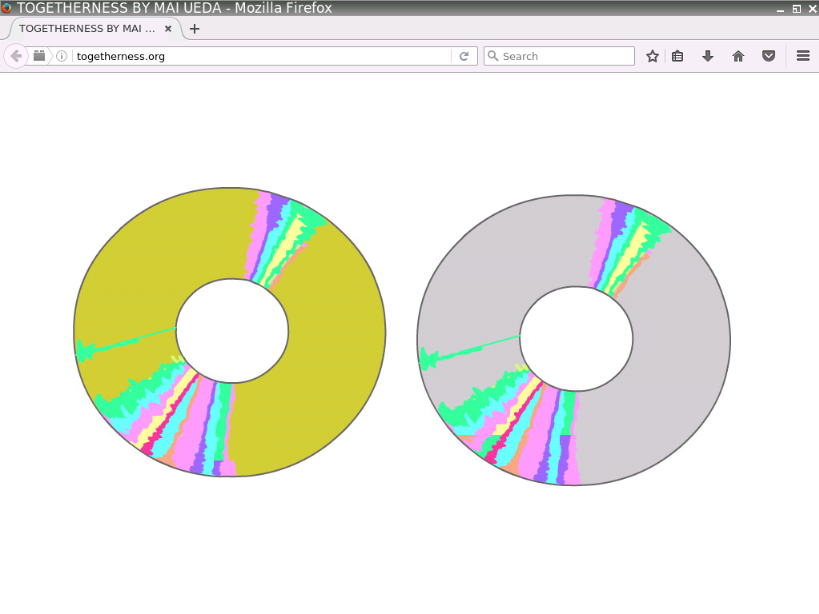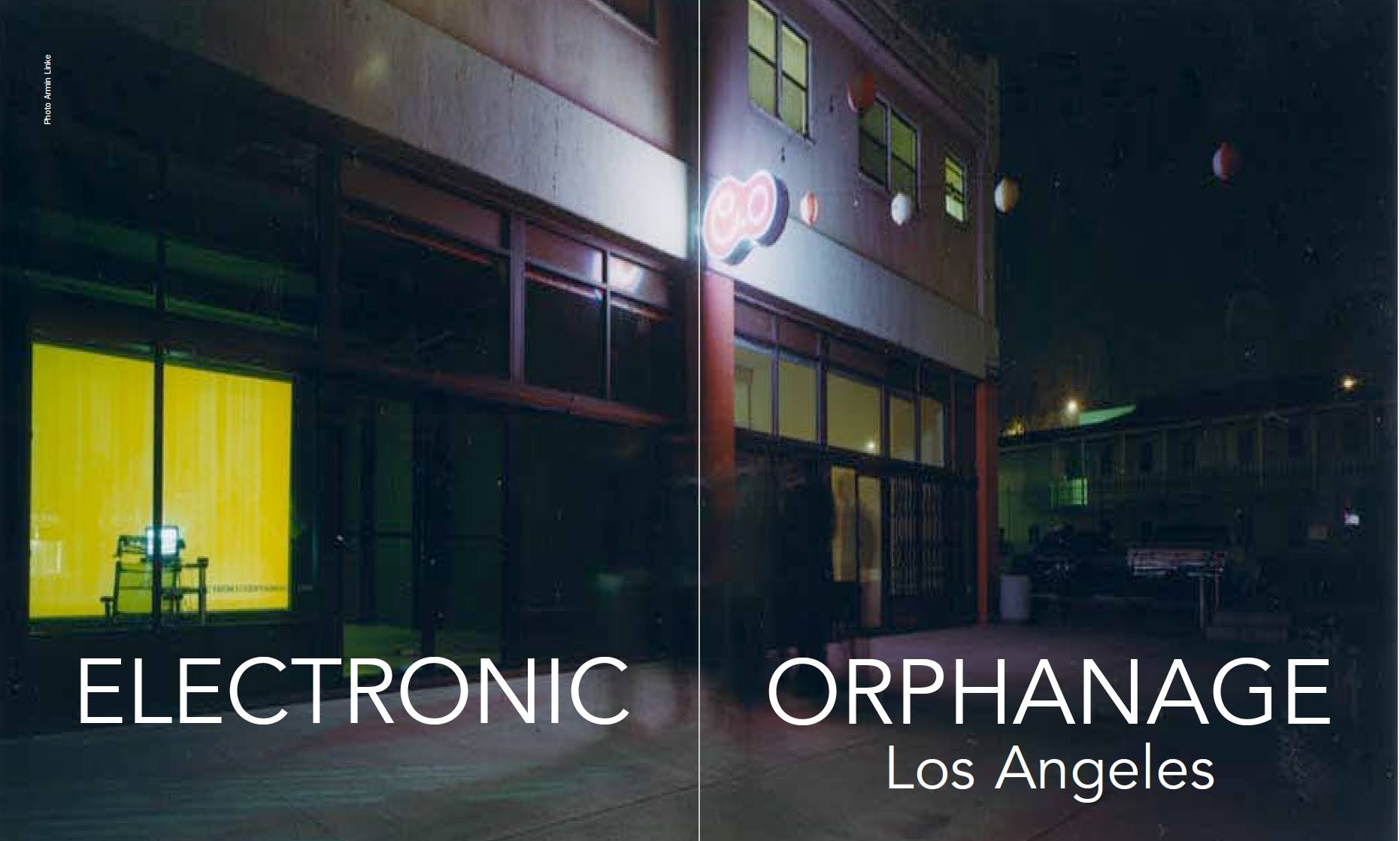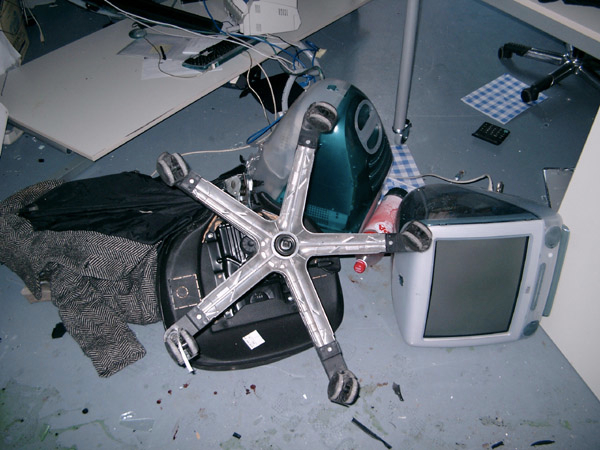This interview accompanies the presentation of Neen as a part of the online exhibition Net Art Anthology, and is part of a series of interviews with Neen participants. Other interviewees are Rafaël Rozendaal, Andreas Angelidakis, and Nikola Tosic. Domenico Quaranta also contributed an essay on Neen in the context of net art.
Michael Connor: Would you mind starting from the beginning of the story? Isn’t the whole idea of having a branding agency come up with the name, isn’t it antithetical to the history of artistic movements? It’s the opposite in a way.
Mai Ueda: I’ve studied many, many different things, but I didn’t want to be categorized into something that's already existed. I was living in New York in Williamsburg at the time, and then met Miltos Manetas, who was coming up with his new art movement, that he wanted it to be about technology and internet.
Then, he heard me singing in my room. We were roommates in a huge artist’s loft. He just asked me, “Do you want to perform in my show next to my painting?” So we kind of invented this new performance that I played with interactive interface thing, called the Big Brother. Then, I was singing classical music childishly as I played with this interface. It was at a galerie Almine Rech in Paris. This was my first work. Then, at the time, Miltos was choosing a name for this new art movement, and then had many list of names from the [advertising agency] Lexicon. I liked this name, Neen.
MC: What did it mean to you to be a Neenstar? What kinds of things would you do under the label of Neenstar? Have you continued to use that label to describe your practice over time, or was there a particular moment?
MU: I was not exposed to art or the typical art mind, so I gave very much input to Miltos. Then we kind of created this movement together. I said, “I want to be a Neen star.” Then Miltos was like, “Oh, Neen-ster, with an E,” so S-T-E-R. STER. Then I was thinking star with A, S-T-A-R.
So Miltos’s way of thinking how he thought was more Telic, which was another name that he was interested in from Lexicon’s [who Manetas worked with to name Neen] list. Telic means in Greek, is like, “ending,” or something. Miltos’s way of approaching it was more left-brain and information-oriented, and my way of approaching it was more intuitive and spontaneous and feeling-oriented. Somehow in between, it was a kind of good balance to create a new art movement.
He read about Lexicon in Wired Magazine, and it was more like left-brain technology kind of dealing with its naming. “Neen” was invented by a computer program. That was a kind of accidental way of coming to this word, I think, more like a big bang kind of way. In a way, accidental, organic and spontaneous, I think.

Mai Ueda, togetherness.org, 2002. Screenshot created in Oldweb.today using Firefox 49 for Linux.
MC: What kinds of things would you do under the label of Neenstar? Have you continued to use that label to describe your practice over time, or was there a particular moment?
MU: It was for me to not become anything, but to become everything, because I didn't want to be categorized as “artist.” I didn't know what it meant, also. But instead, if I’m a Neenstar, I could be whatever I want. I can identify what it is, and just be myself and then that can be called something. So, that was excuse for me to have a playground and be professional on everything I do.
So, I could play with software I’ve invented in the museum, and then take a nap or something like that, in the museum, and then to be flown, to go visit around the world, and being invited to do what I do. My profession was to be myself, which can be called being a Neenstar.
MC: Have you continued to use that label to describe your practice over time, or was there a particular moment?
MU: No, it changed over time. I think I became Telic instead of Neen, because also being a pioneer on things is very hard. It has highs and lows. It’s fun but then people don’t understand, and people want to always categorize you with something that they’ve known already. So Neen brought us to so many spontaneous occasions and fun events, but then couldn’t convince boring adults to trust us. Neen was also on Wikipedia, but then some painter was very jealous of Neen and Miltos, and all this situation, they would spend all their energy to take it off on Wikipedia.
That was kind of amazing. We were trying to fight against it, but then just happened to let it be whatever it wants to. Then Wikipedia people decided to make Neen unofficial. But then it existed, also. So it’s kind of a strange impermanence. I find Neen close to Zen philosophy, too, somehow, for its impermanence and ephemerality.
MC: Can you talk about other people becoming involved in Neen? How did that happen? Who were some of their key figures?
MU: It was a personal encounter for us to find Neenstars. One of the first Neenstars was Rafaël Rozendaal. We found this website where he changes his mustache and hairstyle, and then we were like, “Whoa, this is so fun. He's a Neenstar.” So we contacted Rafaël and went to see him in Amsterdam, and became friend, and invited him to Electronic Orphanage. That’s our space me and Miltos started in Los Angeles, in Chinatown, on Chung King Road. Then Rafaël came, and had one of the first shows in Electronic Orphanage. Then, Lev Manovich also was a Neenstar.
MC: It’s funny, because I think internet artists at the time were so against commercial tools, and even .com web addresses.
MU: It didn’t have to be like this project or that project. But more about personalities and their approach to life. Also, it didn’t have to be commercial, because anything pioneering cannot prove to be commercial immediately. So Miltos would make a painting of people playing a videogame or things, and then it would make money, like a ticket for us to do whatever we want.

Mai Ueda, The Domain Poems, onestar press, 2007
We were totally into .com web addresses. I was always inventing .com domain names as a poem, and I published a book in 2005 from a French publisher called onestar press. It’s called The Domain Poems. Yeah, one of the things we were excited was to make domain name as a poetry. Then also we used the technology as an emotional tool, to make video or performative poetry, too. I have played with Aibo.
MC: The robot dog?
MU: Yeah, because that dog had some kind of a pattern that he reacted to pink or red color, so it can play with a ball that comes with it. But thing I have discovered, it plays with any kind of red, so I have made him into a foot fetishist by wearing red shoes and stuff like that.
Neen was more about playing with technology, too, and not only about internet. But then technology had a fault, so you can play with this fault, and make it poetic. I remember one of Miltos’s artwork was Lara Croft or Super Mario, because video games where you don’t play with the character as you are supposed to, they start to do very poetic things by themselves.
MC: They would fall asleep or something, right?
MU: Hmm? Fall asleep, or...I don't know. Yes, Super Mario falls asleep and makes zzz…and sleep talk, also one airplane that was supposed to fly, would float on the water or things like that. Then Miltos would make a print out of this picture, or make a video, or things like that, too
MC: Where did you do the Aibo performance? Was that at Electronic Orphanage?
MU: Aibo was at the Electronic Orphanage, and then in the museum in Chicago. Also, the photo of it was on a French magazine called Influx, I think. This magazine has finished after two issues or something. But I was on the cover with Aibo.
MC: During this time when Neen was first launched, were you getting much reception from the art world, as well as from the media world?
MU: Not so much from art world, except one place in Amsterdam called Mediamatic. They were founded by net people, I think, like Net Video Now or something. They found us interesting, and they invited us many times. But then the curator of Mediamatic, Paul Groot, was also editor of Flash Art a long time ago, so they knew Miltos and then they were interested in technology, so it was good combination for them to be interested in Neen. But it took a lot of sophistication to understand Neen at the time. Art world/ fashion world reacted more to Electronic Orphanage, as it’s a scene was a little easier for people to digest, Jeffrey Deitch fell in love with a space on Chung King Road and teleported Electronic Orphanage into his gallery for a week, that was in Soho at the time. Olivier Zham featured a big story in Purple Magazine on E.O.
MC: You mentioned that it was more to Zen for you. Can you tell me a little more about that?
MU: Because somehow we think ephemeralness is poetic, and accidental beauty is poetic, which connects with nature. It is about philosophy on way of living (in the electric age), and art comes after it as side products.
MC: Neen was very much about accidental beauty?
MU: I think so, for me at least.
MC: How does that relate to the Neen understanding of people’s relationship with computers and the internet? I feel like Neen had a very particular idea of what the computer, what it mean to people, or how people use the computer or internet.
MU: That’s true. Because if people use the computer as just a tool to get something done, that was not Neen. Instead, if they use it for poetic reasons, then it can have a potential to become Neen. We say Neen art cannot have a particular goal of where they are going, and instead you just take a car to drive and to get lost, that could be Neen, you know? If you are going somewhere, like taking your kid to kindergarten, it cannot be Neen, but if you encounter a donkey crossing the green light on the way back, that is Neen.
MC: Right. How is that different from Telic?
MU: Telic has a goal. They use computer to get to somewhere, like to talk to somebody or find address for a restaurant or something. But then, even something trying to be art, it can be Telic, too, because the aesthetic of it somehow is not cute or something like that. Neen also has to have a sense of humor.
MC: Maybe even trying to be art is a goal in its own way.
MU: That’s true. Trying to be art is very Telic. I guess, also, Zen is in that way. Zen writing, like the ink painting of Zen has no ego. As soon as people try to become something or to have a goal, it involves ego, so that becomes Telic.
MC: Does that mean anything political becomes Telic? Can Neen never be political if it can never have a goal?
MU: Political... Yeah, maybe. But then, political things can produce accidental beauty. We support the idea of copy left and collaborated a lot with Pirates Bay. Being open to ideas and sharing is very important.
MC: Maybe we can talk a little more about Electronic Orphanage. You mentioned it was a space you and Miltos ran. What kind of space was it in?
MU: That was on Chung King Road in Chinatown [in Los Angeles]. Then, at the time, China Art Objects had just opened. Maybe we were like the next one to move in on the same street. That was a very poetic street with, like, wontons in the rundown restaurants and stuff, like Jackie Chan shot some action movies on the restaurant on the same street. But it’s kind of a very small, Chinatown kind of thing.
Then, other galleries moved in next to Electronic Orphanage like a year later or something. That was little by little found by pioneering people, and then became a gallery district. Some galleries that are active now started from here, at some point, many people would come for opening night. It was full of people. Then we had Electronic Orphanage, which is a space, one room all painted black except one wall that was at the end, so it was like a black cube with white wall that was a screen, and we would project one work that we found on the internet or commissioned to artist on opening day. But it was not for sale or anything, that was just an experimental project space kind of thing.
Then, we would also project art at night, or also people could just hang out, just play video games, or do web surfing on the weekdays. Then, sometimes it was Miltos’s painting studio, also like a place where we can shoot pictures for Miltos to paint, or things like that.

MC: Describe the night at Electronic Orphanage. It could be a specific one.
MU: Sometimes we were just in an empty space being on a computer, or sometimes [we were] projecting a huge animation by one of the Neenstars. Then people can just come in, also. The door was open, but then there’s no product to sell or anything, so most people would not come in, which was kind of...I don’t know in English. But in Japanese it's called “kekkai,” it means "invisible boundary.” There was psychological boundary for normal people to not come in, but then interesting people would come in, because obviously it’s kind of out of a science fiction movie or something, this space, and projecting something beautiful on this one huge wall, and then it’s all black space. We invested on amazing chair that was super-technology chair. That was in the middle of the room.
This director, Barbet Schroeder, one time came in, and then we became friends also. Barbet. Yeah. He’s in Wes Anderson films and stuff, too. Also Godard films. He’s also a director. He directed Single White Female, I think. Very interesting character. He’s always looking for something sharp, so he just saw us and came in, and we became friends. Also the scientist, Steven Schkolne. He’s like a giant. He’s more than two meters high, I think. He’s a scientist. He was also one of the Neenstars, too. He came in and start to type computer to show us his works and stuff with his big hands, and the computer looked super-small. He can carry me on his palm or something. So like these very surrealistic beautiful first encounters were happening every night, like magic. Nothing was calculated or expected.
MC: Were you involved in the project that launched at CascO?
MU: Yes, I remember. Was that the one that got crashed by a car?
MC: Yes, can you tell me about that?
MU: I was there on the opening day, and I don’t remember so much, but I think we had been there for a week or something, setting up a show. Then, as soon as the show started, it got crashed by a car accidentally. It was called SuperNEEN, I think? Yeah. It was kind of impossible because it was by the canal. But then car was parked in front or something, and then startup got wrong, and then just car drove all the way into the gallery, and then crashed all the computers in the show. Yeah, it sounds like a performance piece, but it was not planned.
Aftermath of the CascO crash, December 15, 2002. Credit: Miltos Manetas.
MC: Was that the end of Neen, of the moment?
MU: Yeah. That was the end of Neen, I think. Everybody was kind of falling apart and losing interest on it, because nobody got personal profit from it, you know? Yeah. I think Nikola Tosic has wrote successful version of Neenstars or something on his poem. Do you know Nikola Tosic? Ah, he's one of most Neen Neenstar, I think. He writes poems every day, I think, on website. There was a poem by him about successful version of a Neenstar, or something like that. On this version of the universe, Neenstars has became like potential success on commercial kind of world, and each had kind of success on commercial terms. Like me on becoming a cover of Italian Vogue or things like that. Then, I don't remember. You should check out. Ask Nikola, also.
Neen was a good exercise for all of us to think and learn. I even learned English through it. I remember learning the word existentialism from Lev Manovich in a usual sunny day in our (Miltos and my) Silver Lake house. These moments are original and luxurious.
Header image: Miltos Manetas, MAI UEDA IS PLAYING ABSTRACT SUPERMARIO IN MEDIA CITY, SEOUL, KOREA, OCT 2002

